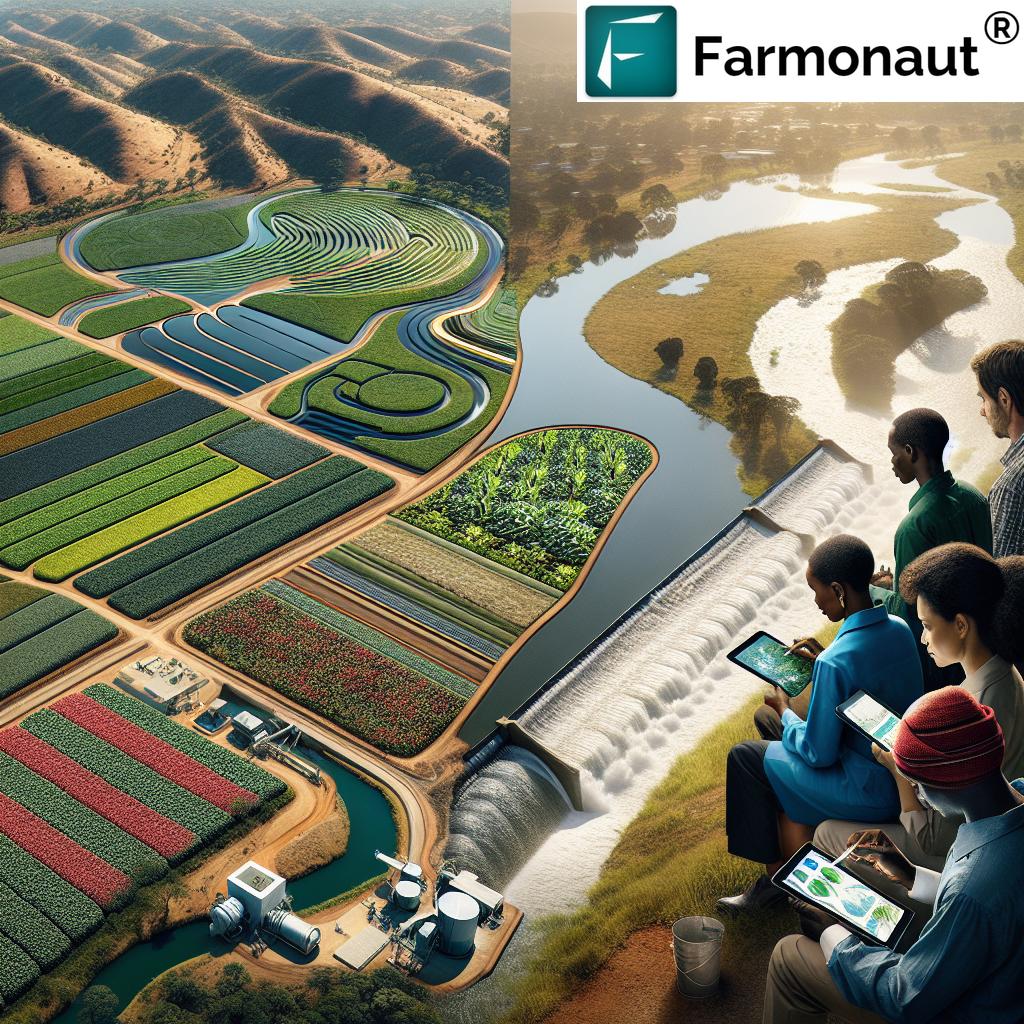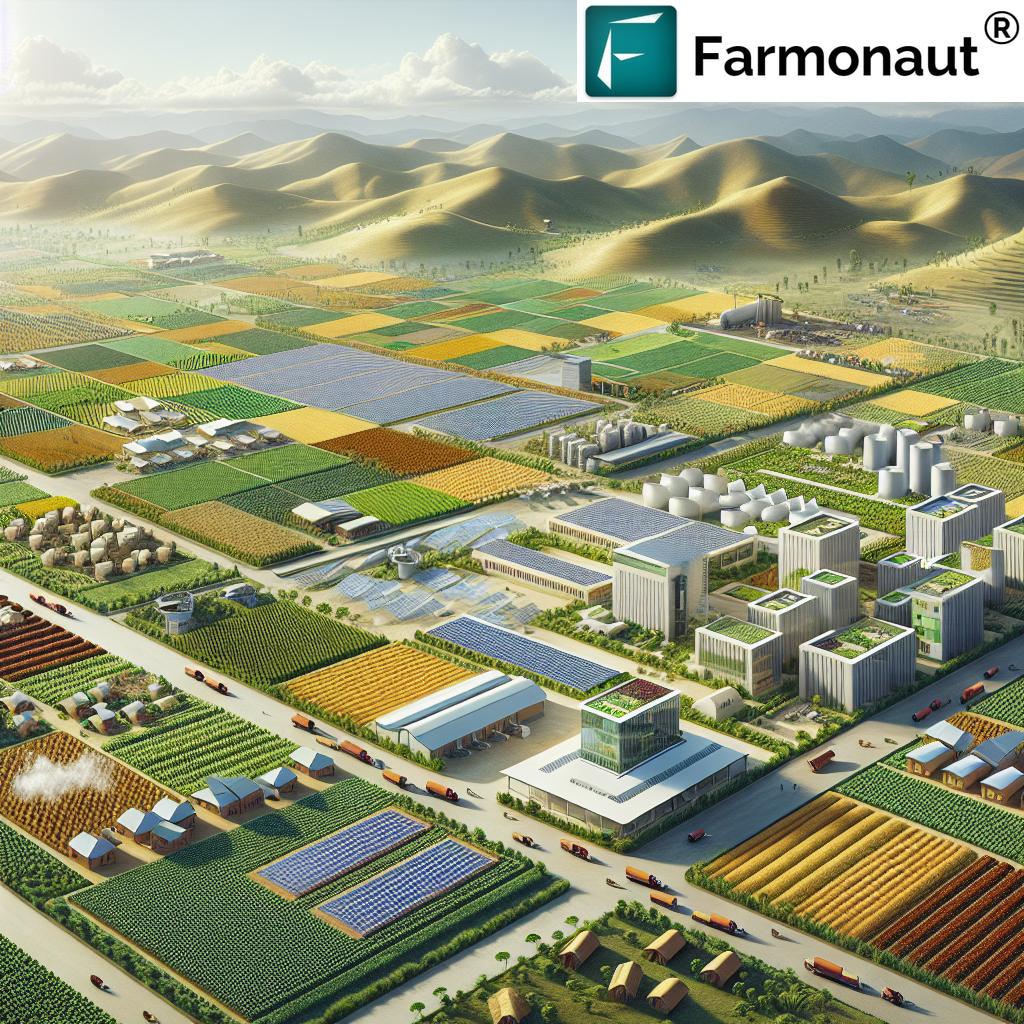Table of Contents
- Introduction: Broccoli Growth in Zimbabwe for 2025
- Understanding Innovations: The Role of Satellite Data in Broccoli Cultivation
- Broccoli Crop Growth Stages and Climate Adaptation in Zimbabwe
- Top 5 Yield Strategies for Broccoli Growth Zimbabwe 2025
- 1. Harnessing Satellite Monitoring for Real-Time Crop Insights
- 2. Optimizing Soil Health: pH, Salinity, SOC, and Nutrient Balance
- 3. Smart Nutrient Management: Chemical and Organic Approaches
- 4. Water and Irrigation Management: Precision via Remote Sensing
- 5. Weed, Pest & Disease Control: Satellite-Driven, Integrated Management
- Comparison Table: Satellite Data vs. Traditional Broccoli Growth Practices in Zimbabwe
- Farmonaut Product Platforms & Useful Links
- FAQs on Broccoli Growth, Satellite Monitoring, and Advanced Agriculture in Zimbabwe
- Conclusion: Building a Data-Driven Broccoli Future in Zimbabwe
Broccoli Growth Zimbabwe: 5 Top Yield Strategies 2025
Zimbabwe’s agriculture sector is undergoing a remarkable transformation as we approach 2025—driven by innovations in satellite data, remote sensing, and precision nutrient management. Nowhere is this shift more evident than in the broccoli growth and production landscape, especially in regions like Goromonzi and other prime horticultural zones.
With changing climate, increased stressors, and evolving market demands, optimizing crop yield for high-value vegetables like broccoli has become both a science and an art. Utilizing actionable crop and soil insights via advanced data, Zimbabwean farmers are unlocking new levels of productivity, sustainability, and profitability in vegetable production.
In this comprehensive guide, we break down the top 5 data-driven strategies for broccoli growth in Zimbabwe for 2025—covering satellite monitoring, nutrient and moisture management, pest and weed control, and how satellite-based solutions from technology leaders like Farmonaut can transform your broccoli fields from average to outstanding.
Understanding Innovations: The Role of Satellite Data in Broccoli Cultivation
Achieving optimal broccoli growth in Zimbabwe’s dynamic agriculture landscape relies on understanding the actual conditions of your soil, water resources, plant nutrient status, and canopy health throughout each development stage. Traditional scouting and laboratory testing, while useful, often leave information gaps—especially over larger farms or under variable weather.
Enter satellite data and remote-sensing technologies: These provide continuous, farm-wide monitoring of key variables such as:
- NDVI (Normalized Difference Vegetation Index): Indicates crop greenness, healthy leaf development, and early signs of stress.
- SAVI (Soil Adjusted Vegetation Index): Especially useful for sparse broccoli stands or at seedling/early vegetative stages where exposed soil may skew readings.
- NDWI (Normalized Difference Water Index): Tracks field moisture status to guide irrigation scheduling, particularly in climates with increasing unpredictability.
- Soil and canopy temperature: Early warning for water stress, heat stress, and the prediction of pest/disease outbreaks.
Harnessing these indicators—precisely and in real time—increases yield and resource efficiency compared to traditional methods (by 10–20%, according to FAO and recent Zimbabwean data).
As data from organizations like the Food and Agriculture Organization of the United Nations (FAO), Ministry of Lands, Agriculture, Fisheries, Water and Rural Development (Harare, Zimbabwe) shows, successful broccoli production hinges on technology adoption in soil, nutrient, moisture, and crop canopy monitoring. With the expansion of affordable satellite data, every broccoli farmer—big and small—can leverage these tools.
Broccoli Crop Growth Stages and Climate Adaptation in Zimbabwe
Before diving into the top yield strategies, let’s review the typical development and growth stages for broccoli in Zimbabwe, focusing on high-potential regions like Goromonzi. Timing of management actions is critical—every stage (seedling, vegetative, head initiation, head development/curd enlargement, harvest) demands specific nutrient, water, and canopy management:
- Seedling (transplant): 0-30 days after sowing. Delicate and susceptible to environmental stress and weed pressure.
- Vegetative Growth (Leaf Development): 30-70 days. Rapid leaf expansion and critical canopy development for future yield. NDVI/SAVI typically increases. Soil N and water are essential.
- Head Initiation: 70-90 days. Plants start shifting resources to produce the central curd (broccoli head). Requires balanced nutrients, especially potassium (K) and phosphorus (P).
- Head Development (Curd Enlargement): 90-120 days. Maximal yield potential built—nutrient deficiencies (even short-term) can reduce head size and quality. Precise monitoring with satellite indices is crucial.
- Harvest/Maturity: 120–150 days. Broccoli ready for harvest. Delayed harvest reduces quality—real-time crop status supports optimal timing.
In Zimbabwe—with irrigation—broccoli can be sown in cycles: September–November for summer harvests (December–February), and February–April for winter harvests (May–July). Each season requires adaptive management to match variable temperature, rainfall, and potential pest/disease cycles. (Source: Ministry of Lands, Agriculture, Fisheries, Water and Rural Development, 2023)
Typical local yield potential, according to FAO (2022, Rome, Italy), United Nations, local agricultural extension, and recent field data for broccoli in Zimbabwe:
- Expected minimum: 4,000 kg/acre
- Expected maximum (good management): 6,000 kg/acre
- Highest recorded (optimal): 8,000 kg/acre
With satellite-guided management, increasing from the lower to the upper end of this range is now within every grower’s reach!
Top 5 Yield Strategies for Broccoli Growth Zimbabwe 2025
Below, we detail the five powerful, evidence-based strategies to maximize broccoli yield, enhance soil and plant health, and create resilient, sustainable production systems using a blend of satellite data, nutrient management, and smart farming innovations.
1. Harnessing Satellite Monitoring for Real-Time Crop Insights
In 2025, satellite monitoring is no longer futuristic—it’s an essential tool for maximizing broccoli growth in Zimbabwe. By tracking dynamic changes in NDVI, SAVI, and NDWI throughout the crop cycle, farmers gain actionable intelligence to guide every key decision:
- Transplant to vegetative stage: NDVI typically rises from 0.2–0.3 to 0.7+ as healthy leaf area increases—low or plateau indicates stress, pest/disease, or fertilizer need.
- Canopy & curd development: SAVI is critical for early, sparse canopies (0.4–0.7 optimal in vegetative stage). NDWI alert signals allow for pinpoint irrigation adjustments to avoid water stress or root issues.
- Data-driven advisories: We (at Farmonaut) deliver AI-based crop health advisories—backed by satellite data—covering recommended management, application rates, fertilizer types, and much more.
In Goromonzi and similar Zimbabwean districts, evidence shows that farmers using remote sensing for broccoli increased yields by 10–20% compared to traditional field scouting alone (Sources: FAO, 2022; Ministry of Lands, Agriculture, Fisheries, Water and Rural Development, 2023).
Key Benefits:
- Continuous, unbiased crop health monitoring—even under cloud or heat stress, with higher granularity than field visits.
- Alert-based detection of emerging deficiencies (N, P, K, Zn, S), water stress, pest risks, poor canopy, and yield-limiting “hidden hunger”.
- Rapid identification of weed outbreaks, irrigation imbalances, and crop management issues.
- Supports precision interventions with fertilizer and irrigation—leading to lower costs and higher yields.
Want to experience actionable, satellite-driven advisory directly? Explore Farmonaut’s Large Scale Farm Management Solution—ideal for integrated broccoli production, tracking, and multi-field visibility.
2. Optimizing Soil Health: pH, Salinity, Organic Carbon, and Nutrient Balance
Broccoli yield potential is only as good as your soil health. Optimal pH (6.2–6.5), low salinity, and high soil organic carbon (SOC, ideally 3–5%) create conditions for maximum nutrient uptake and strong plant development:
- pH: Broccoli thrives within the 6.2–6.5 range. Below or above this, nutrient availability drops, affecting the actual uptake even when fertilizers are applied according to guidelines.
- Salinity: High due to over-application of soluble potassium chloride or low drainage. Moderate to high salinity can reduce root growth and nutrient uptake (especially K and Zn).
- SOC (Soil Organic Carbon): Many Zimbabwean vegetable fields have critically low SOC (0.14–0.16%). Optimal range: 3–5%. Compost, cover crops, and reduced tillage are recommended to increase level—improving moisture retention and nutrient cycling.
Field data (FAO, 2022; Ministry 2023) show that broccoli fields in Goromonzi with improved organic matter returned significantly higher yields and resilience to drought stress in cycles sown September through November (with actual yield improvement of ~12–15%).
Smart Monitoring Approaches:
- Satellite indices track canopy response to soil amendments—increasing SAVI/NDVI signals successful health recovery after organic input application.
- Salinity “hotspot” mapping for targeted gypsum or rainfall leaching.
In summary: Balanced pH, low salinity, rising SOC, and a monitored nutrient status create the foundation for high-yield broccoli fields, especially under the sub-humid, often variable Zimbabwean regimes.
Improve Your Access to Crop Loan & Insurance: Satellite data provides verified, unbiased yield and health records, streamlining eligibility for crop loans and insurance for broccoli growers.
3. Smart Nutrient Management: Chemical and Organic Approaches
Effective nutrient management is central to achieving the higher end of broccoli yield (6,000–8,000 kg/acre) in Zimbabwe. Both chemical and organic fertilizer sources play a role, with timing, balance, and adaptation to actual soil composition making all the difference.
- Nitrogen (N): Key for vegetative leaf expansion. Ideal levels: 18.2–27.3 kg/acre (PSNT, FAO guidelines). Urea, Ammonium Nitrate (chemical) and Compost/Farmyard Manure (organic) are commonly used in local practice.
- Phosphorus (P): Needed for rooting, curd/head development, and stress tolerance. Typical soil range: 22.8–36.4 kg/acre. Triple Superphosphate, Single Superphosphate (chemical); Bone Meal, Rock Phosphate (organic). Application rate depends on actual gap; split applications recommended to avoid fixation.
- Potassium (K): Supports head formation, stress resilience, and water-use efficiency. Ideal: 136.5–182.0 kg/acre. Muriate of Potash, Potassium Chloride/Sulphate (chemical); Wood Ash, Compost (organic).
- Sulfur (S), Zinc (Zn): Micronutrients often overlooked. Zinc Sulphate (chemical), gypsum, and compost bridge gaps. Typical gap identified by remote sensing is 10–20% higher than what field scouting detects!
Calculated Example for Broccoli in Goromonzi (Based on FAO, 2022; Ministry 2023):
- If P is at 22.75 kg/acre (slightly below mid-ideal), and phosphorus gap is 6.85 kg/acre,
Apply Triple Superphosphate at 11.5 kg/acre or Bone Meal at 264.5 kg/acre in 3 split doses every 3 days during vegetative and head initiation stages. - K and N levels must be checked using recent satellite data and actual ppm (parts per million) from soil profiles.
Adapt application rates to actual, not assumed, field conditions, and always split fertilizer doses as per guidelines—this avoids fertilizer burn and maximizes uptake.
Want to simplify nutrient tracking? Use Farmonaut Traceability Platform—ensure every application, from zinc to superphosphate, is logged, verified, and auditable for supply chain and food safety requirements.
Best Practices:
- Apply chemical fertilizers (urea, ammonium nitrate, triple superphosphate, potassium chloride) as per real-time advisory—based on gap analysis (NDVI/SAVI-based), not set calendar.
- Promote organic fertilizer use (compost, bone meal, wood ash) to raise SOC and improve soil structure long-term.
- Alternate chemical with organic to moderate pH and salinity impacts (wood ash raises pH, ammonium nitrate lowers pH).
- Monitor results via savvy digital records (see traceability link above) and re-adapt rates as per advisory—especially as broccoli enters curd enlargement stages.
Remember: Optimal broccoli growth depends on matching nutrient application to current, not theoretical, soil and plant status—using modern satellite analytics for both precision and compliance.
4. Water and Irrigation Management: Precision via Remote Sensing
Zimbabwe’s variable rainfall patterns and increasing climate unpredictability make precision irrigation critical for broccoli crop yield—especially in key productive hubs like Goromonzi where both sprinkler irrigation and varying water sources are used.
- Sprinkler irrigation is predominant for vegetable crops, allowing for uniform coverage and efficient fertilizer dissolution—supported by satellite-monitored NDWI trends.
- Remote-sensed NDWI values (0.11–0.26 optimal)—rising values mean adequate moisture; declining signal need for more frequent applications (e.g., every 2–3 days during vegetative/head development stages).
- Data-adapted application rates: For instance, 6.0 mm every 2 days during head enlargement with moderate evapotranspiration (~5.5 mm/day) ensures optimal supply without waste or waterlogging.
Other key water management recommendations:
- Time irrigation for early morning (05:00–08:00) to minimize evaporation losses.
- Never skip recommended irrigation days during critical stages if there is no rain—water stress at head formation can cost you up to 30% in marketable yield.
- Apply soluble fertilizer (e.g., urea, potassium chloride, zinc sulphate) directly through sprinkler systems for rapid correction of nutrient gaps.
Optimize Your Irrigation Fleet with Farmonaut—track machinery and irrigation schedules for large broccoli farms across Goromonzi and beyond, reducing downtime and maximizing coverage.
5. Weed, Pest & Disease Control: Satellite-Driven, Integrated Management
Effective weed, pest, and disease management is non-negotiable for maximizing broccoli yields—especially when canopy cover is sparse or stress is present (“stress” is often indicated by declining SAVI/NDVI).
- Common weeds: Pigweed (Amaranthus spp.), Blackjack (Bidens pilosa), Mexican marigold, Witchgrass. High weed prevalence is indicated by low SAVI and increasing NDWI—open canopy with moisture encourages fast germination. Use chemical pre-emergents (Pendimethalin) and hand weeding/mulching for best results.
- Pests: Aphids (probable, moderate to high risk), Diamondback moth (high risk during vegetative and head development), Cabbage looper, Cutworms. Remote sensing can predict outbreaks by tracking sudden dips in SAVI.
- Diseases: Black rot (high-risk in humidity), Downy mildew, Alternaria leaf spot, Clubroot. Early detection paired with chemical (Copper fungicides, Mancozeb, Chlorothalonil) and organic solutions (crop rotation, improved air flow) is essential.
Integrated Satellite-Advisory for Disease & Pest Management:
- Monitor rapid, localized drops in SAVI/NDVI—often the earliest sign of pest or disease.
- Combine chemical control (Spinosad, Imidacloprid) with organic (Bt sprays, Neem oil, crop rotation, compost application) for reduced resistance risk.
- Keep canopy cover optimal (SAVI 0.7–0.85) to shade out many weed species and reduce pest/disease outbreaks.
- Adjust field operations and crop protection frequency in real time as new advisories arrive—responding within 2–3 days of a stress alert.
Learn More: Broccoli Crop & Plantation Advisory Use farm-specific remote sensing advice to tailor weed, pest, and disease management plans for every cycle and region.
Comparison Table: Satellite Data vs. Traditional Broccoli Growth Practices in Zimbabwe
| Broccoli Growth Strategy | Technology Used | Estimated Yield Improvement (%) | Impact on Soil Health | Nutrient Management Efficiency |
|---|---|---|---|---|
| Traditional Practice | Manual scouting, periodic lab testing, fixed fertilization schedule | 0–5% compared to baseline | Moderate (slower improvement); SOC and pH optimization is reactive, often delayed | Moderate; many deficiencies go undetected until visual symptoms appear, fixed/frequent application rates lead to waste |
| Satellite-Driven Management | Satellite NDVI/SAVI/NDWI monitoring, real-time AI-based advisory, adaptive fertilizer scheduling | 10–20% yield boost (based on trials, 2022–2024) | High; early detection and targeted management rapidly restores pH, SOC; results visible within single cycles | High; nutrient application matches actual, field-level gaps; more efficient, less wasteful, hidden deficiencies promptly corrected |
Satellite data and AI-based advisory deliver measurable advantages for Zimbabwe’s broccoli producers—especially in responding to climate extremes and changing pest/disease profiles seen in recent years.
Integrate Satellite Crop Data into Your System via Farmonaut API—Perfect for agricultural extension, analytics, and enterprise farm management platforms.
Review the API Developer Documentation for streamlined setup and technical guidance.
Track Your Farm’s Carbon Footprint—Meet new sustainability guidelines and open up premium vegetable export market opportunities with transparent, data-driven records.
Farmonaut Platforms: How to Access Satellite Insights for Broccoli Production
Farmonaut’s world-leading satellite and AI-based advisory platform makes precision monitoring of broccoli growth, nutrient needs, water status, and yield estimates accessible and affordable—from any web, Android, or iOS device.
- Farmonaut Web App lets you monitor field health, schedule inputs, and track crop development through the growing season—vital for large growers and cooperatives in Zimbabwe.
- Farmonaut Android App enables on-the-go monitoring, tailored for Zimbabwe’s on-field extensionists and operational managers.
- Farmonaut iOS App gives you the same intuitive tools for Apple users—monitoring, alerting, record-keeping, and compliance checks.
- Crop Plantation & Advisory Platform delivers field-specific Crop-Advisory and plantation-level insights—empowering you from sowing to harvest.
Whether you manage 2 or 200 acres of broccoli in Zimbabwe, Farmonaut automates complex data into straightforward actions—proven to:
- Increase broccoli and vegetable yields sustainably
- Improve nutrient-use efficiency and reduce environmental impact
- Support compliance for certification and traceability programs
- Enable year-round irrigation and weed management precision
FAQs on Broccoli Growth, Satellite Monitoring, and Advanced Agriculture in Zimbabwe
Q1: What is the ideal pH, salinity, and organic carbon level for broccoli growth in Zimbabwe?
For optimal broccoli development, maintain a pH of 6.2–6.5, low salinity, and soil organic carbon (SOC) between 3–5%. Typical soils in Zimbabwe may need adjustment via compost and gypsum application, as organic matter is often critically low (0.14–0.16%) in vegetable fields.
Q2: How does satellite data improve broccoli nutrient management?
Satellite platforms like Farmonaut analyze NDVI, SAVI, and NDWI to detect hidden nutrient gaps (such as N, P, K, Zn, S) before visible symptoms. This enables targeted, timely fertilizer application (e.g., superphosphate, ammonium nitrate, bone meal, wood ash) and reduces waste while boosting yield.
Q3: What irrigation method is recommended for broccoli in Zimbabwe?
Sprinkler irrigation is widely recommended for broccoli, as it ensures uniform coverage, supports soluble fertilizer application, and is efficient even in variable water conditions. Adjust frequency and rate (typically 5–6mm every 2 days during key stages) based on NDWI remote sensing values.
Q4: What are the most common broccoli pests and diseases in Zimbabwe, and how can they be managed?
Pests: Aphids, Diamondback moth, Cabbage looper, Cutworms.
Diseases: Black rot, Downy mildew, Alternaria leaf spot, Clubroot.
Satellite data allows for early outbreak prediction and localized treatment. Combine chemical (Spinosad, Imidacloprid, Copper fungicides) and organic methods (Neem, crop rotation), adjusting in real time as advisories update.
Q5: How often should nutrient levels be checked during broccoli growth?
We recommend using remote-sensed NDVI/SAVI every 7–10 days (or more often at critical stages) to capture dynamic changes in nutrient, moisture, and canopy status throughout broccoli’s 3–4 month development period.
Q6: Is Farmonaut only for large commercial farms?
No—Farmonaut’s solutions are scalable and accessible to all—smallholder, medium, and large-scale operations, as well as for use by agricultural extension, enterprises, and government agencies. Subscriptions are affordable and tailored to your acreage and frequency needs.
Conclusion: Building a Data-Driven Broccoli Future in Zimbabwe
The path to high-yield, resilient broccoli production in Zimbabwe in 2025 is clear—integrate satellite monitoring, precision nutrient management, adaptive irrigation, and smart weed-pest protocols, all underpinned by regular digital advisories. As climate, pest, and input challenges mount, only a data-driven agriculture framework supports long-term success, profitability, and sustainable food security.
Farmonaut satellite and AI-powered advisory platforms—via web, iOS, Android, and flexible API/app integrations—bring the future of vegetable crop management within reach of every Zimbabwean grower. Easily track each field’s progress, close nutrient gaps, monitor canopy and moisture development, and maximize marketable broccoli yield—while meeting extension and compliance guidelines.
As we look to the 2025 and future harvests, let’s embrace technology, act on real-time insights, and reap the rewards of precision, sustainability, and prosperity in Zimbabwean horticulture.















